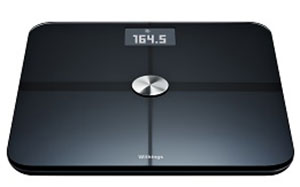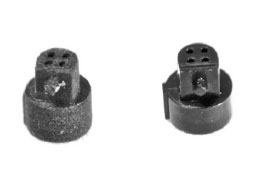Withings is a company that develops and brings to market a range of devices and applications designed to help individuals monitor and track their health. Founded in 2009, Withings has introduced a number of smart products — lifestyle-friendly devices that integrate a wireless network and fit seamlessly into people’s lives by connecting to phones and computers to provide information about various aspects of their health. The company now works with more than 100 partner apps and services to this end.

The key aspect of this new product is indeed the new air quality sensor that checks indoor air quality by measuring temperature and carbon dioxide levels. The tracking app builds a CO2-level graph highlighting thresholds that have a detrimental effect and alerts users as and when necessary.
A key and long-used strategy for product development at Withings is the integration of 3D printing early in the development process to validate its designs, eliminate risk where possible and improve time to market. Bastien Rechke, an R&D mechanical engineer at Withings, explained: “In the development process, there are always phases during which we use 3D printing. It is really helpful to have physical pieces in your hands to make the right choices. It is also a way for us to add the sense of touch to the visual perception [of a design]. Designers often create a design just as we describe it to them, but after seeing it for real, we notice that we need to change something. In the long run, 3D printing processes have a deep consequence on the quality of our products.”
It’s well documented that utilising 3D printing for rapid and iterative prototyping negates the risk of flaws at the tool manufacturing stage of the industrial process, and this is what Withings finds too. Ensuring the correct fit and mechanical function of components before tooling production is absolutely essential. Indeed, with the capabilities of current industrial grade 3D printer, including accuracy within a few microns, functional prototypes are really close to what will come out of a mould in the conventional production process.
As Bastien Rechke concluded: “In the past, it might have been difficult to reach such a precision in the prototyping phase, but it’s now not only possible but also really affordable. It might take a little bit of time ahead in the process, but in the end it is something that can save us lots of time and money. Creating a mould is something that takes weeks and still is highly priced, 3D printing helps us to be 100% sure of its quality before we launch into production.”
But until now, Withings had never considered using 3D printing as a manufacturing process. But necessity challenged the perception of 3D printing as a prototyping process.
Despite every in-house effort, production can still go awry because a supplier cannot meet deadlines. And this is what happened at the final stages of the WS-50 production schedule. The Withings team had contracted a mould manufacturer to create three plastic pieces to hold the new air quality sensors in place on the circuit board. However, the supplier contacted Withings to inform them of a delay in the mould production schedule, which would inevitably mean a delay to the launch of the new Smart Body Analyser by couple of weeks — if something wasn’t done, it would mean broken commitments to reseller channels and potentially damaging consequences for the business.
Having insider knowledge of 3D printing for prototyping, the R&D engineers at Withings considered the idea of employing 3D printing to solve this issue. To this end, they contacted French 3D printing service provider Sculpteo for help with a tight brief to 3D print the three required pieces with next to no lead-time, in high volumes.
Jean-Raphael Ouin, a mechanical engineer on the R&D team at Withings, picked up the story: “We already knew the precision of 3D printing would be sufficient to fit the mechanical requirement of the pieces. And for us, it was a really affordable way to solve a problem and avoid a delay in the process. For the first time at Withings, we considered integrating 3D printed parts directly into the finished product.”

Sintering process being used for the application; printing in Polyamide PA-12 material. The powder-based process produced multiple, accurate parts relatively quickly but post-processing proved tricky – and this is an oft-overlooked part of the entire 3D printing process. In this case, cleaning out the unsintered powder from the cavities was an issue — Sculpteo’s conclusion was that the small holes in the design
needed to be bigger for better and faster cleaning. Because the cleaning process is done by hand, Sculpteo also opted to print every unit attached to a frame. That way it was easier to insert a little string to clean the holes. Even despite this, after just 24 hours, the first production issues were solved. Withings had verified the three pieces fitted the circuit board and Sculpteo was ready to launch into the production of several thousand 3D printed pieces that would be used in the final production models of the Smart Body Analyser. Jean-Raphael Ouin commented: “In the end, there were only a few iterations during the process. We came to Sculpteo with a precise need. We sent them the 3D file of our design, and they took care of the rest. A day later, they came to us to see if larger holes would affect the requirements for the part. Since it was not an issue for us, we fixed the design and it went directly into production.”
Withings were delighted with the service they received from Sculpteo, and were super impressed with the automated ordering service, together with the collaborative efforts of the Sculpteo team to meet their needs. Bastien Rechke sums this up: “Everything is incredibly automated. For the client, the solution comes down to a file upload and to using an e-commerce solution with fast and efficient customer service.” Regarding the cost of the solution, Jean-Raphael Ouin added: “At the time we reached out to Sculpteo, 3D printing was for us by far the most cost effective solution. The cost per unit was indeed higher than for any unit produced by a mould, but we chose this solution to fix a problem under the given circumstances, which would likely have been more damaging. We didn’t need to integrate anyone in our team or in the factory; also we didn’t need to buy any computer or even a 3D printer. But most of all, we gained an amazing amount of time and saved an incredible amount of money. The three weeks we saved for the production of our new product were largely worth paying a little bit more for every unit of those three pieces.”
Source: Scribd


